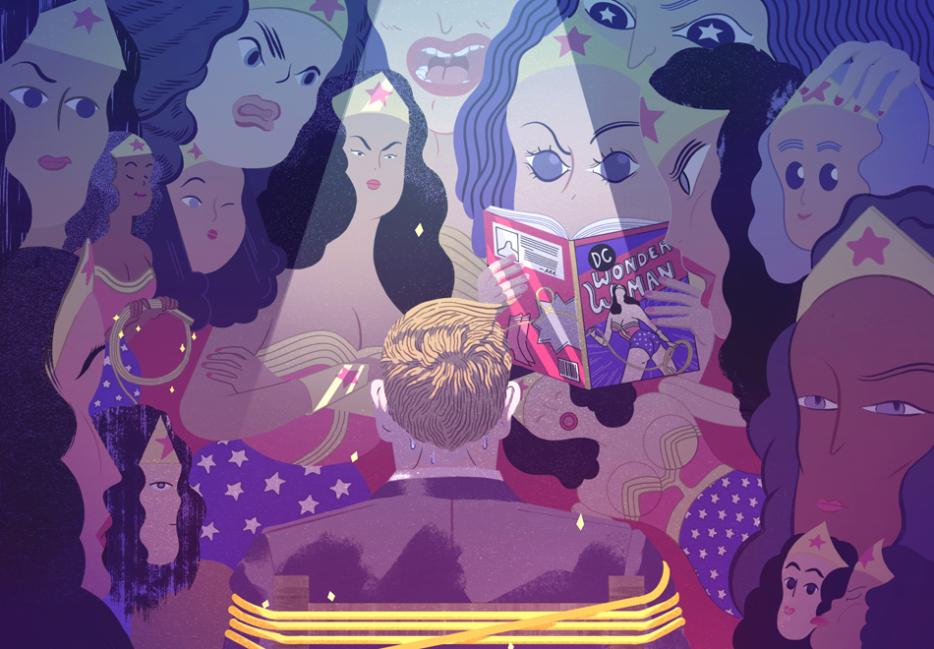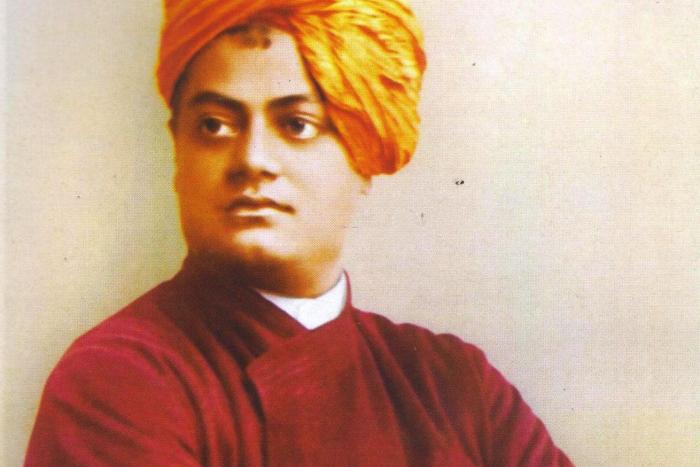The men’s rights movement emerged in the early 1970s and persists as a 21st-century pestilence. Yet, as far back as the Second World War, Wonder Woman foresaw the possibility that anti-feminists would one day portray themselves as heroic victims. A science fiction story titled “America’s Wonder Woman of Tomorrow,” which ran in Wonder Woman #7 (Winter 1943), showed the Amazon Princess fending off a fierce backlash when she runs for the presidency of the United States. Upset at the prospect of a superheroine commander-in-chief, the villainous Professor Manly forms the Man’s World Party. Senator Hemann takes up the cause, arguing, “The men of this country are fed up with woman’s oppression! The Man’s World Party demands male rights!” In the end, Wonder Woman triumphs as she always does, not just winning the White House, but also vanquishing the forces of revanchist chauvinism.
The fact that the gender battles of our time were mapped out in the now yellowing pages of a 71-year-old comic book is not so surprising after reading Jill Lepore’s new book, The Secret History of Wonder Woman, which convincingly demonstrates that the most beloved superheroine of all time was created by an amorous cabal of feminists and sex radicals. The reference books have long told us Wonder Woman was the brainchild of Dr. William Moulton Marston, a Harvard-certified psychologist who also invented the prototype for the lie detector test. Yet as Lepore makes clear, Marston was the front-man for a trio of startlingly unconventional women who were the inspirations for the character. As Marston stated in 1945, “Frankly, Wonder Woman is psychological propaganda for the new type of women who, I believe, should rule the world.” The women Marston loved and lived with were the models for this “new type” of female conqueror.
Depending on how one does the arithmetic, Marston lived in a ménage à trois or a ménage à trois et demi. He and his childhood sweetheart Sadie Holloway were both born in 1893 and married each other in 1915, combining all-conquering intelligence with sexual adventurousness. Both got law degrees while also doing advanced research in psychology, and, were it not for the sexism of the period, Holloway likely would have gotten a doctorate in psychology to match her husband, having contributed to his groundbreaking work in the systolic blood pressure test. Holloway was also a classicist whose most cherished poet was Sappho, the ancient celebrator of lesbian desire.
In 1926, the Marston-Holloway duo expanded to include Olive Byrne, a decade younger and the daughter of feminist royalty. Byrne’s aunt was Margaret Sanger, the world’s leading advocate of birth control and the sexual liberation of women, while her mother, Ethel Byrne, had been jailed for offering information about birth control to impoverished New York women. Byrne inherited her radical politics from her mother and aunt, with the added twist of being a strong champion of sexual diversity. Byrne always wore bracelets, which in comic book form became the magic cuffs Wonder Woman uses to bounce off bullets.
Holloway could read ancient Greek, so she knew that the root word “poly” meant much, or many. Her husband Marston, a polymathic polygamist polygraphist, was a man of many sides, some of which contradicted each other—a charlatan and a visionary, a huckster and a genius.
Holloway and Byrne had two kids each with Marston. At times, the household triangle was temporarily re-arranged into a rectangle when it was joined by Marjorie Wilkes Huntley, a freethinking librarian with a passion for bondage. Huntley would stay as a guest at the Marston-Holloway-Byrne residence, serving as an aunt to the kids even as she added spice to an already hearty erotic stew. Her interest in bondage is the likeliest source for the frequent BDSM imagery that the early Wonder Woman comics flirt with.
By bringing together feminism and sexual diversity, the Marston clan raised all sorts of interesting dilemmas; not every advocate of women’s right will find the trios version of sexual equality to be congenial. Lepore, who is a just-the-facts positivist historian, makes no judgments herself, but is attentive to contradictions and fault lines. Based on her own account, though, we can try to make sense of how feminism relates to the Wonder Woman threesome (or foursome).
Holloway could read ancient Greek, so she knew that the root word “poly” meant much, or many. Her husband Marston, a polymathic polygamist polygraphist, was a man of many sides, some of which contradicted each other—a charlatan and a visionary, a huckster and a genius. Based on his path-breaking lie detector work, he could’ve had a stellar academic career, but he damaged his own reputation by fudging his results and dabbling in sensationalism (including research into the sexual subtext of sorority initiation rites). As a champion of gender equality, he decried men who wanted to keep women in “haremlike” subjugation, yet his own family could have easily been mistaken for just that.
Triangles come in different shapes. Did Marston rule over an isosceles triangle, with him at the top, living off two (and sometimes three) devoted mates? Olive’s brother, pulp magazine editor Jack Byrne, certainly thought so, distrusting Marston as a “ladies man.” Undeniably, in the 1930s before the creation of Wonder Woman, we could see the Marston household as having an unequal division of labour. Holloway’s income as an Encylopedia Britannica editor kept the family afloat, Byrne took care of the four kids, and Marston just dabbled in unsuccessful business plans and writing ventures. The Marston of the 1930s could be viewed as an exploiter, a pampered pet living off his wives. It was only when one of his brainstorms turned into a phenomenally popular superheroine that he started to pull his own weight in the family.
But on the emotional level there are reasons to think that Marston-Holloway-Byrne family was an equilateral triangle. Although Lepore doesn’t say so explicitly, there’s every reason to believe that Holloway and Byrne loved each other as much as they doted on Marston. After Marston died in 1947, Holloway and Byrne lived together for the rest of their lives, often sharing a bed, until Byrne died in 1990, their union lasting 64 years. Wonder Woman came from the all-female Paradise Island, which, as the writer Katha Pollitt suggests, might be a good metaphor for the lives Holloway and Byrne made with each other.
But aside from the polygamy, what are feminists to make of the pervasive bondage imagery in Wonder Woman? “In episode after episode, Wonder Woman is chained, bound, gagged, lassoed, tied, fettered, and manacled,” Lepore writes. In one of his notes to the artist Harry G. Peter, Marston offered these instructions of what he wanted to see in a story where Wonder Woman fights some Martians: “Closeup of WW still lying face down. The paddle is just hitting her buttocks. The Martian does not show in this panel, only the spanker. Show the descent of the paddle with action lines and stars, etc.” For a 1940s comic book that appealed to pre-teen girls and boys, this is fairly startling.
To this day, the big two publishers of superhero comics struggle to create plausible and popular female characters; the superhero genre is one where women characters often seem to exist only to be raped and murdered.
As Stacey May Fowles has noted, “BDSM… makes a lot of people uncomfortable, and the concept of female submission makes feminists really uncomfortable.” It’s not surprising that when Gloria Steinem helped assemble a collection of Wonder Woman reprints in 1972, she excluded the many bondage-themed stories Marston wrote. But if Steinem was made uneasy by Marston’s fetishist tendencies, other feminists might find reasons to see his advocacy of sexual diversity as praise-worthy.
In his 1928 book Emotions of Normal People, Marston offered a full-throttled and pioneering celebration of sexual diversity in its myriad forms, including, as Lepore notes, “homosexuality, transvestitisms, fetishism, and sadomasochism.” According to Marston, all of these practices are hardwired into our brain, and psychological health is based on accepting them. “People must be taught that the love parts of themselves, which they have come to regard as abnormal, are completely normal,” Marston argued. (Perhaps crossing an ethical line, Byrne wrote an enthusiastic review of the book for the Journal of Abnormal and Social Psychology.) Marston’s arguments for the bondage imagery in Wonder Woman as imaginative play prefigures the case contemporary writers like Fowles make that BDSM can be empowering performance. Just as Fowles sees no contradiction between BDSM and feminism, we can see the stories of Wonder Woman being tied up and freeing herself as allegories of female strength.
The Wonder Woman comics of the 1940s were not just startlingly ahead of their time in their frank advocacy of gender equality, but in many ways are still ahead of our time, During the Second World War, Wonder Woman was part of the elite pantheon of heroes that included Superman and Batman. After Marston died, DC comics handed rein of the character to Robert Kanigher, an avowed anti-feminist who over the course of nearly 20 years rendered Wonder Woman into a man-worshipping ninny. To this day, the big two publishers of superhero comics struggle to create plausible and popular female characters; the superhero genre is one where women characters often seem to exist only to be raped and murdered. The zeal and elan of the original Wonder Woman is needed more than ever. Even in 2014, the lessons that the trio of Marston-Holloway-Byrne taught about sexual diversity and female empowerment are still worth attending to. The Wonder Woman who fought the Man’s World Party in 1943 remains a champion worth celebrating.





